
A garden is a planned space, usually outdoors, set aside for the cultivation, display, and enjoyment of plants and other forms of nature. The single feature identifying even the wildest wild garden is control. The garden can incorporate both natural and artificial materials.

A closet is an enclosed space, with a door, used for storage, particularly that of clothes. Fitted closets are built into the walls of the house so that they take up no apparent space in the room. Closets are often built under stairs, thereby using awkward space that would otherwise go unused.

Tok Pisin, often referred to by English speakers as New Guinea Pidgin or simply Pidgin, is an English creole language spoken throughout Papua New Guinea. It is an official language of Papua New Guinea and the most widely used language in the country. However, in parts of the southern provinces of Western, Gulf, Central, Oro, and Milne Bay, the use of Tok Pisin has a shorter history and is less universal, especially among older people.

Stairs are a structure designed to bridge a large vertical distance between lower and higher levels by dividing it into smaller vertical distances. This is achieved as a diagonal series of horizontal platforms called steps which enable passage to the other level by stepping from one to another step in turn. Steps are very typically rectangular. Stairs may be straight, round, or may consist of two or more straight pieces connected at angles.

A shed is typically a simple, single-story roofed structure, often used for storage, for hobbies, or as a workshop, and typically serving as outbuilding, such as in a back garden or on an allotment. Sheds vary considerably in their size and complexity of construction, from simple open-sided ones designed to cover bicycles or garden items to large wood-framed structures with shingled roofs, windows, and electrical outlets. Sheds used on farms or in the industry can be large structures. The main types of shed construction are metal sheathing over a metal frame, plastic sheathing and frame, all-wood construction, and vinyl-sided sheds built over a wooden frame. Small sheds may include a wooden or plastic floor, while more permanent ones may be built on a concrete pad or foundation. Sheds may be lockable to deter theft or entry by children, domestic animals, wildlife, etc.

An apartment, flat, or unit is a self-contained housing unit that occupies part of a building, generally on a single story. There are many names for these overall buildings. The housing tenure of apartments also varies considerably, from large-scale public housing, to owner occupancy within what is legally a condominium or leasehold, to tenants renting from a private landlord.

A bungalow is a small house or cottage that is single-storey, sometimes with a smaller upper storey set in the roof and windows that come out from the roof, and may be surrounded by wide verandas.
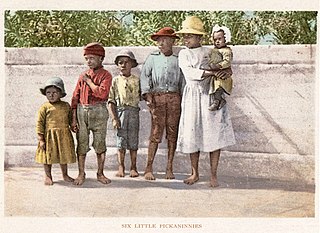
Pickaninny is a pidgin word for a small child, possibly derived from the Portuguese pequenino. It has been used as a racial slur for African American children and a pejorative term for Aboriginal children of the Americas, Australia, and New Zealand. It can also refer to a derogatory caricature of a dark-skinned child of African descent.

An outhouse is a small structure, separate from a main building, which covers a toilet. This is typically either a pit latrine or a bucket toilet, but other forms of dry (non-flushing) toilets may be encountered. The term may also be used to denote the toilet itself, not just the structure.
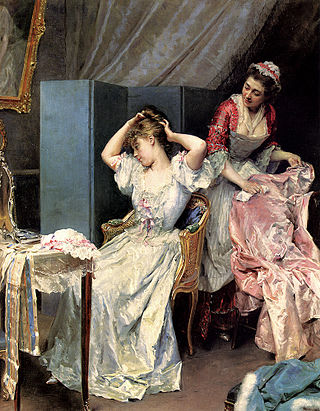
A maid, housemaid, or maidservant is a female domestic worker. In the Victorian era, domestic service was the second-largest category of employment in England and Wales, after agricultural work. In developed Western nations, full-time maids are now typically only found in the wealthiest households. In other parts of the world, maids remain common in urban middle-class households.
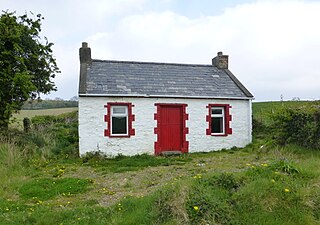
A cottage, during England's feudal period, was the holding by a cottager of a small house with enough garden to feed a family and in return for the cottage, the cottager had to provide some form of service to the manorial lord. However, in time cottage just became the general term for a small house. In modern usage, a cottage is usually a modest, often cosy dwelling, typically in a rural or semi-rural location and not necessarily in England. The cottage orné, often quite large and grand residences built by the nobility, dates back to a movement of "rustic" stylised cottages of the late 18th and early 19th century during the Romantic movement.

A Wendy house, in the United Kingdom, is a children's playhouse that is large enough for one or more children to enter. Size and solidity can vary from a plastic kit to something resembling a real house in a child's size. Usually there is one room, a doorway with a window on each side, and little or no furniture other than what the children improvise.

A dovecote or dovecot, doocot (Scots) or columbarium is a structure intended to house pigeons or doves. Dovecotes may be free-standing structures in a variety of shapes, or built into the end of a house or barn. They generally contain pigeonholes for the birds to nest. Pigeons and doves were an important food source historically in the Middle East and Europe and were kept for their eggs and dung.
Western Australian English is the English spoken in the Australian state of Western Australia (WA). Although generally the same as most other Australian English, it has some state-specific words – including slang and Aboriginal words – and variations in pronunciation.

The Romanichal are a Romani subgroup within the United Kingdom and other parts of the English-speaking world. Many Romanichal speak Angloromani, a mixed language that blends Romani vocabulary with English syntax. Romanichal residing in England, Scotland, and Wales are part of the Gypsy (Romani), Roma, and Traveller community.
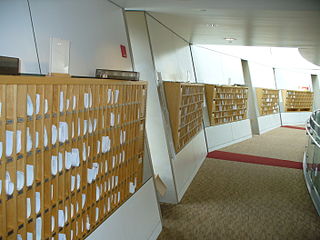
A pigeon-hole messagebox is an internal mail system commonly used for communication in organisations, workplaces and educational institutes in the United Kingdom and other countries. Documents and messages are placed in a person's pigeon-hole for them to collect; they can reply by putting a response inside the sender's pigeon-hole.

Wattle and daub is a composite building method used for making walls and buildings, in which a woven lattice of wooden strips called "wattle" is "daubed" with a sticky material usually made of some combination of wet soil, clay, sand, animal dung and straw. Wattle and daub has been used for at least 6,000 years and is still an important construction method in many parts of the world. Many historic buildings include wattle and daub construction.
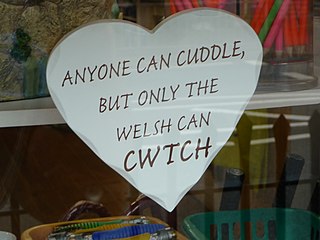
English orthography typically represents vowel sounds with the five conventional vowel letters ⟨a, e, i, o, u⟩, as well as ⟨y⟩, which may also be a consonant depending on context. However, outside of abbreviations, there are a handful of words in English that do not have vowels, either because the vowel sounds are not written with vowel letters or because the words themselves are pronounced without vowel sounds.

The Bogey Hole, also known as the Commandant's Baths, is a heritage-listed sea bath in Newcastle in New South Wales, Australia. It is thought to be the oldest surviving European construction in the city area. The pool was hewn from a sandstone/conglomerate rock shelf at the base of cliffs near Shepherds Hill. Lieutenant-Colonel James Thomas Morisset, the Commandant of Newcastle (1818–23), ordered the construction of the pool by convict labour in about 1820 for his own use.

Cubbyhole, sometimes written as Cubby Hole or Cubby, in Manhattan's West Village, is one of New York City's three remaining lesbian bars as of 2022.




















